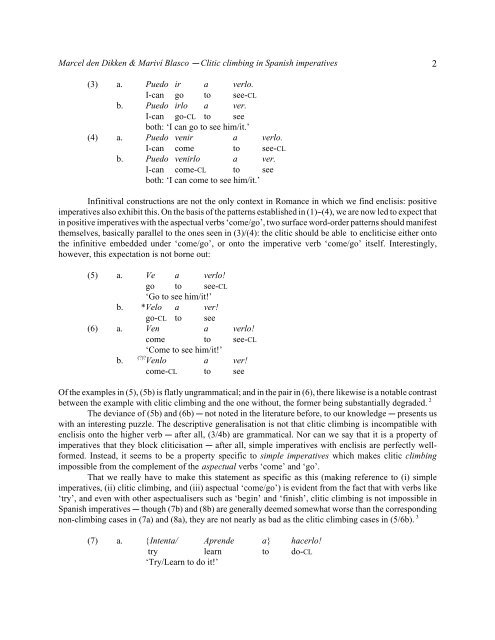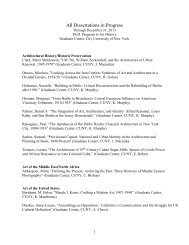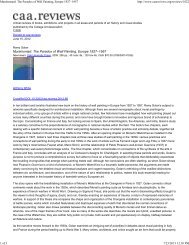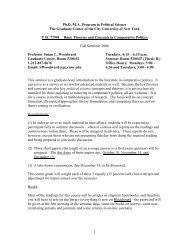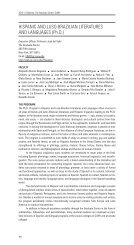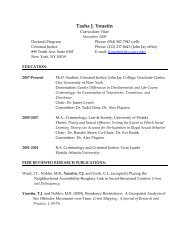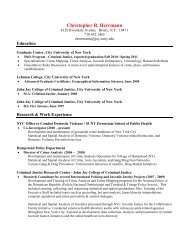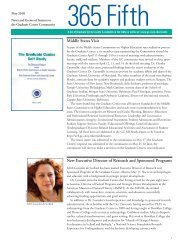Clitic climbing in Spanish imperatives - CUNY Graduate Center
Clitic climbing in Spanish imperatives - CUNY Graduate Center
Clitic climbing in Spanish imperatives - CUNY Graduate Center
Create successful ePaper yourself
Turn your PDF publications into a flip-book with our unique Google optimized e-Paper software.
Marcel den Dikken & Mariví Blasco & <strong>Clitic</strong> <strong>climb<strong>in</strong>g</strong> <strong>in</strong> <strong>Spanish</strong> <strong>imperatives</strong><br />
(3) a. Puedo ir a verlo.<br />
I-can go to see-CL<br />
b. Puedo irlo a ver.<br />
I-can go-CL to see<br />
both: ‘I can go to see him/it.’<br />
(4) a. Puedo venir a verlo.<br />
I-can come to see-CL<br />
b. Puedo venirlo a ver.<br />
I-can come-CL to see<br />
both: ‘I can come to see him/it.’<br />
Inf<strong>in</strong>itival constructions are not the only context <strong>in</strong> Romance <strong>in</strong> which we f<strong>in</strong>d enclisis: positive<br />
<strong>imperatives</strong> also exhibit this. On the basis of the patterns established <strong>in</strong> (1)%(4), we are now led to expect that<br />
<strong>in</strong> positive <strong>imperatives</strong> with the aspectual verbs ‘come/go’, two surface word-order patterns should manifest<br />
themselves, basically parallel to the ones seen <strong>in</strong> (3)/(4): the clitic should be able to encliticise either onto<br />
the <strong>in</strong>f<strong>in</strong>itive embedded under ‘come/go’, or onto the imperative verb ‘come/go’ itself. Interest<strong>in</strong>gly,<br />
however, this expectation is not borne out:<br />
(5) a. Ve a verlo!<br />
go to see-CL<br />
‘Go to see him/it!’<br />
b. *Velo a ver!<br />
go-CL to see<br />
(6) a. Ven a verlo!<br />
come to see-CL<br />
b.<br />
‘Come to see him/it!’<br />
(?)? Venlo a ver!<br />
come-CL to see<br />
Of the examples <strong>in</strong> (5), (5b) is flatly ungrammatical; and <strong>in</strong> the pair <strong>in</strong> (6), there likewise is a notable contrast<br />
between the example with clitic <strong>climb<strong>in</strong>g</strong> and the one without, the former be<strong>in</strong>g substantially degraded. 2<br />
The deviance of (5b) and (6b) & not noted <strong>in</strong> the literature before, to our knowledge & presents us<br />
with an <strong>in</strong>terest<strong>in</strong>g puzzle. The descriptive generalisation is not that clitic <strong>climb<strong>in</strong>g</strong> is <strong>in</strong>compatible with<br />
enclisis onto the higher verb & after all, (3/4b) are grammatical. Nor can we say that it is a property of<br />
<strong>imperatives</strong> that they block cliticisation & after all, simple <strong>imperatives</strong> with enclisis are perfectly wellformed.<br />
Instead, it seems to be a property specific to simple <strong>imperatives</strong> which makes clitic <strong>climb<strong>in</strong>g</strong><br />
impossible from the complement of the aspectual verbs ‘come’ and ‘go’.<br />
That we really have to make this statement as specific as this (mak<strong>in</strong>g reference to (i) simple<br />
<strong>imperatives</strong>, (ii) clitic <strong>climb<strong>in</strong>g</strong>, and (iii) aspectual ‘come/go’) is evident from the fact that with verbs like<br />
‘try’, and even with other aspectualisers such as ‘beg<strong>in</strong>’ and ‘f<strong>in</strong>ish’, clitic <strong>climb<strong>in</strong>g</strong> is not impossible <strong>in</strong><br />
<strong>Spanish</strong> <strong>imperatives</strong> & though (7b) and (8b) are generally deemed somewhat worse than the correspond<strong>in</strong>g<br />
non-<strong>climb<strong>in</strong>g</strong> cases <strong>in</strong> (7a) and (8a), they are not nearly as bad as the clitic <strong>climb<strong>in</strong>g</strong> cases <strong>in</strong> (5/6b). 3<br />
(7) a. {Intenta/ Aprende a} hacerlo!<br />
try learn to do-CL<br />
‘Try/Learn to do it!’<br />
2


